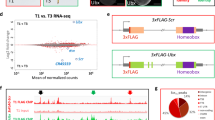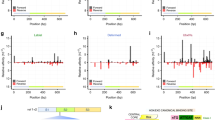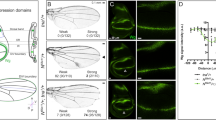Abstract
Homoeotic genes in Drosophila melanogaster are active in spatially restricted metameric domains and control the morphogenesis of segment-specific features such as legs or wings within these domains1. They exert their function, according to the 'selector gene' hypothesis2, by regulating the expression of subordinate genes. Homoeotic genes also control their own expression3 and the expression of each other3–5. The proteins encoded by these genes contain a domain, called a homoeodomain, that is strongly conserved, and that shows homologies to proteins that bind DNA and regulate transcription6,7. Homoeoproteins have been shown to bind specific DNA sequences8–10. We show here that the Drosophila homoeotic genes Ultrabithorax (Ubx) and Abdominal-B (Abd-B) code for proteins that are capable of activating transcription of reporter genes linked to specific cis-regulatory target sequences in transfected mammalian cells. Their activity, as well as their target specificity, is similar to that of a mammalian lymphoid-specific octamer transcription factor, OTF-2, which was recently found to contain a homoeodomain11.
This is a preview of subscription content, access via your institution
Access options
Subscribe to this journal
Receive 51 print issues and online access
$199.00 per year
only $3.90 per issue
Buy this article
- Purchase on Springer Link
- Instant access to full article PDF
Prices may be subject to local taxes which are calculated during checkout
Similar content being viewed by others
References
Akam, M. Development 101, 1–22 (1987).
Garcia-Bellido, A. in Cell Patterning, CIBA Foundation Symposium Vol. 29 (ed. Brenner, S.) 161–182 (New York Associated Scientific, 1975).
Bienz, M. & Tremml, G. Nature 333, 576–578 (1988).
Hafen, E., Levine, M. & Gehring, W. Nature 307, 287–289 (1984).
Struhl, G. & White, R. A. H. Cell 43, 507–519 (1985).
Shepherd, J. C. W., McGinnis, W., Carrasco, A. E., DeRobertis, E. M. & Gehring, W. Nature 310, 70–71 (1984).
Laughon, A. & Scott, M. P. Nature 310, 25–31 (1984).
Desplan, C., Theis, J. & O'Farrell, P. H. Nature 318, 630–635 (1985).
Desplan, C., Theis, J. & O'Farrell, P. H. Cell 55, 1081–1090 (1988).
Hoey, T. & Levine, M. Nature 332, 858–861 (1988).
Müller, M. M., Ruppert, S., Schaffner, W. & Matthias, P. Nature 336, 544–551 (1988).
Ptashne, M. Nature 335, 683–689 (1988).
O'Connor, M. B., Binari, R., Perkins, L. A. & Bender, W. EMBO J. 7, 435–445 (1988).
DeLorenzi, M. et al. EMBO J. 7, 3223–3231 (1988).
Severne, Y., Wieland, S., Schaffner, W. & Rusconi, S. EMBO J. 7, 2503–2508 (1988).
Biggin, M. D. & Tjian, R. Cell 53, 699–711 (1988).
Bienz, M. et al. Cell 53, 5567–5576 (1988).
Westin, G., Gerster, T., Müller, M. M., Schaffner, G. & Schaffner, W. Nucleic Acids Res. 15, 6787–6798 (1987).
Höller, M., Westin, G., Jiricny, J. & Schaffner, W. Genes Dev. 2, 1127–1135 (1988).
Green, M. R., Treisman, R. & Maniatis, T. Cell 35, 137–148 (1983).
Staden, R. Nucleic Acids Res. 10, 2951–2961 (1982).
Fletcher, C., Heintz, N. & Roeder, R. G. Cell 51, 773–781 (1987).
Otting, G. et al. EMBO J. (in the press).
Casanova, J., Sanchez-Herrero, E. & Morata, G. Cell 47, 627–636 (1986).
Casanova, J. & White, R. A. H. Development 101, 117–122 (1987).
Shore, D. & Nasmyth, K. Cell 51, 721–732 (1987).
Sakai, D. D. et al. Genes Dev. 2, 1144–1154 (1988).
Ma, J. & Ptashne, M. Cell 50, 137–142 (1987).
Weinzierl, R., Axton, J. M., Ghysen, A. & Akam, M. Genes Dev. 1, 386–397 (1987).
Jack, T., Regulski, M. & McGinnis, W. Genes Dev. 2, 635–651 (1988).
Saari, G. & Bienz, M. EMBO J. 6, 1775–1779 (1987).
Author information
Authors and Affiliations
Rights and permissions
About this article
Cite this article
Thali, M., Müller, M., DeLorenzi, M. et al. Drosophila homoeotic genes encode transcriptional activators similar to mammalian OTF-2. Nature 336, 598–601 (1988). https://doi.org/10.1038/336598a0
Received:
Accepted:
Issue Date:
DOI: https://doi.org/10.1038/336598a0
This article is cited by
-
Analysis ofcis-regulatory elements involved in the activation of a member of chalcone synthase gene family (PsChs1) in pea
Plant Molecular Biology (1996)
-
Gene inactivation in Drosophiia mediated by the Polycomb gene product or by position-effect variegation does not involve major changes in the accessibility of the chromatin fibre
Molecular and General Genetics MGG (1994)
-
AT-rich promoter elements of soybean heat shock gene Gmhsp 17.5E bind two distinct sets of nuclear proteins in vitro
Plant Molecular Biology (1992)
-
Targets of homeotic gene control in Drosophila
Nature (1990)
-
The Drosophila fushi tarazu polypeptide is a DNA-binding transcriptional activator in yeast cells
Nature (1989)
Comments
By submitting a comment you agree to abide by our Terms and Community Guidelines. If you find something abusive or that does not comply with our terms or guidelines please flag it as inappropriate.



